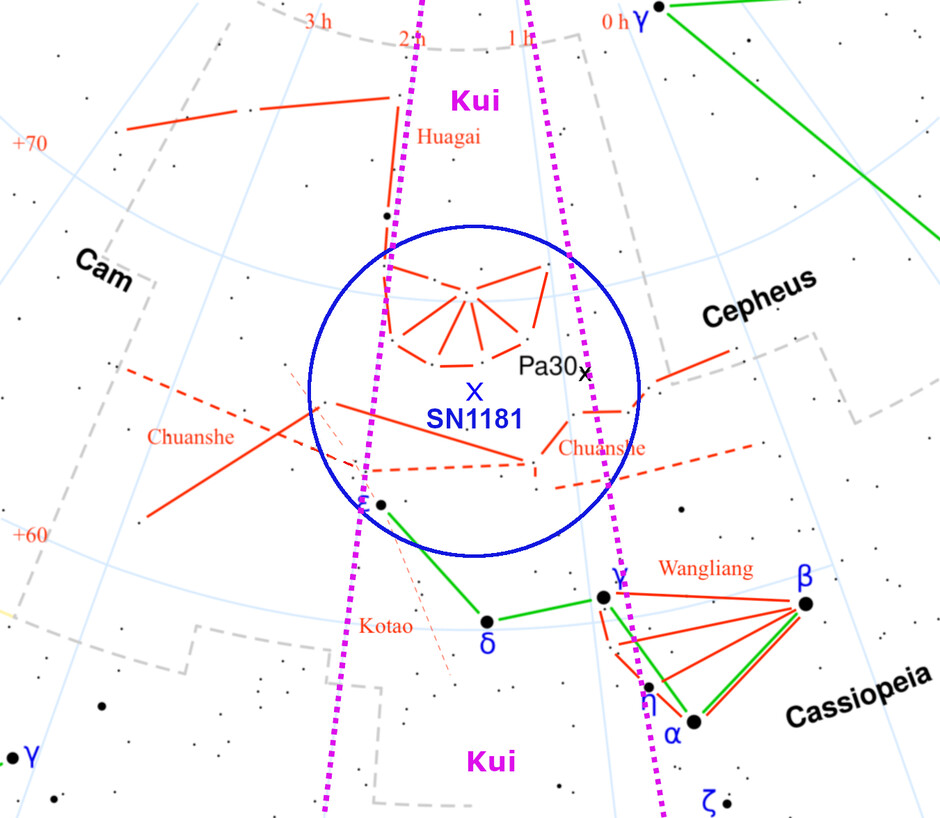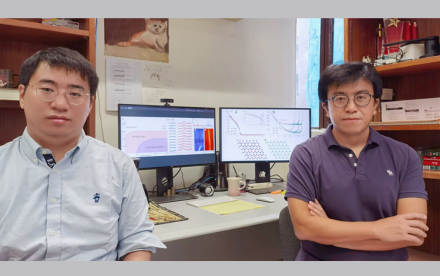15 Sep 2021
An explosive Cosmic Chinese Conundrum - a hot detective story from a very cold case: HKU astrophysicists solve a 900-year-old mystery, giving an ancient Chinese guest star of AD 1181 a place to stay and rest

The best estimated average position of SN 1181 is given by a blue cross surrounded by a blue error circle of radius 5 degrees.
The Chinese have a long, ancient history of recording “guest stars” – suddenly bright stars that appear in the sky for a while but then dim and disappear. Today we know these are rare, incredibly energetic supernova explosions from either massive stars or special, interacting binary systems that seed the Galaxy with heavy elements like iron and leaving behind neutron stars, pulsars, black holes and a gaseous remnant like the Crab nebula.
Now, a 900-year-old mystery on the true origins of the Chinese guest star of AD 1181 has finally been solved by an international team of astronomers. The Laboratory for Space Research (LSR) and Department of Physics of The University of Hong Kong(HKU) joined hands with collaborators from the UK, Spain, Hungary and France, pursued an investigation to unravel this mystery via newly uncovered clues of their own discovery. Remarkably, the guest star of AD 1181, reported at the time to be as bright as the planet Saturn, was the only historical supernova(SN) of the last thousand years that has been without identification with a real object.
Published recently in the prestigious Astrophysical Journal letters, this team reports the identification of SN of AD 1181 with their previous co-discovery in 2017 of “Parker’s star”, the hottest known Wolf-Rayet star (itself a truly unique object) with a temperature of more than 200,000 degrees Celsius. This star also has a surrounding nebula Pa30, discovered by their amateur colleague Dana PATCHICK in 2013.
Corresponding author Professor Quentin PARKER, also the Director of LSR said, “Our data showed the expanding gas cloud from this star has extreme velocities of around 1,100km/s from an explosion about 1,000 years ago. This matches the AD 1181 event. Not only that but Pa30/Parker’s stars position in the sky fits the historical Chinese and Japanese reports on the guest star to within 3.5 degrees – well within the errors,” this after an association first made by co-author Professor Albert ZIJLSTRA, Professor in Astrophysics at The University of Manchester, also a key member of the LSR and a Hung Hing Ying Distinguished Visiting Professor in Science and Technology at HKU.
Pa30 and Parker's star have previously been proposed as the result of a merger of two White Dwarfs – dense dead stars, leading to a rare Type Iax supernova. The reported historical brightness and modern distance determined for their system suggests the event was dimmer than typical supernovae. This also agrees with the rare Type Iax designation, only the second of its kind known in the entire Galaxy.
Dr Andreas RITTER, the paper’s first author and HKU Postdoctoral Fellow within the LSR said, “Taken together, the age, location, reported “Guest star” brightness and recorded visibility for 6 months, shows that Parker’s star and its surrounding gas shroud Pa30 are indeed the counterparts of supernova SN of AD 1181.”
The SN of AD 1181 event is also the only Type Iax supernova where detailed studies of the remnant star and surrounding nebula are possible. Combined with the extreme and remarkable nature of Parker's star itself and their linking of it to the AD 1181 supernova, this source becomes of considerable scientific and historical interest. Finally, Parker's star is the only Wolf Rayet star known that is neither from a massive progenitor star nor the central star of a planetary nebula. Instead, it is the result of two white dwarf stars merging together and accompanied by a Type Iax supernova explosion that now has a firm historical basis.
The Journal paper can be access from here.

The region of SN 1181 with the Chinese asterisms indicated by red lines. The position of Pa30 is shown by a black cross. The green line indicates the modern constellation Cassiopeia. The supernova was stated to lie in the Chinese “lunar lodge” Kui (between the two purple dotted lines) between Huagai and Chuanshe, near Wangliang. The best estimated average position of SN 1181 is given by a blue cross surrounded by a blue error circle of radius 5 degrees.

False colour images of “Parker’s star” and its surrounding nebula Pa30 that make-up the remnants from the SN 1181 AD event. The colours represent the infrared, optical, and UV light. The contours in the central image show X-ray emission. At the distance of 7,500 light years, 45 arc seconds on the sky translate to 100,000 astronomical units. One astronomical unit is the average distance between Earth and the Sun, which is about 93 million miles or 150 million kilometers.






